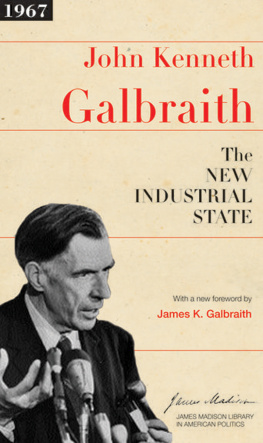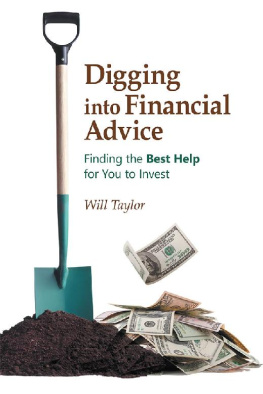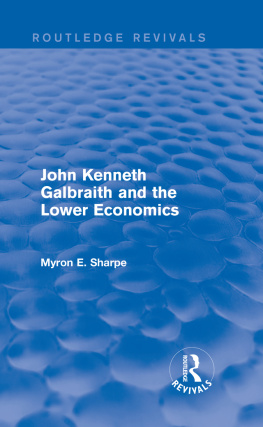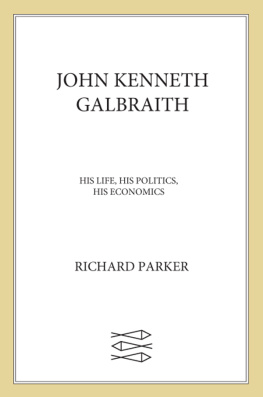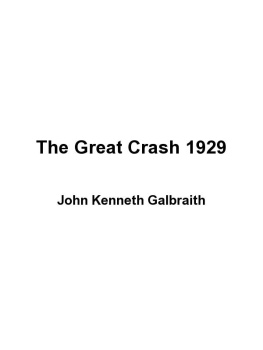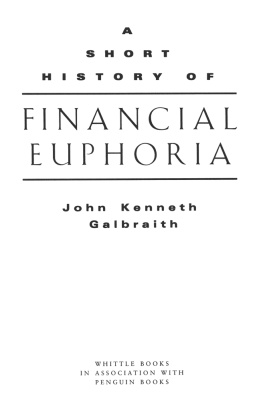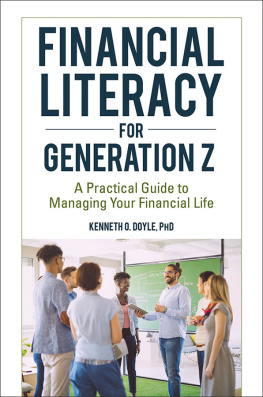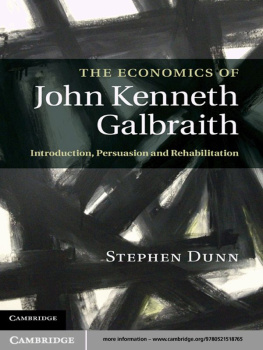
Table of Contents
TO
CATHERINE ATWATER
GALBRAITH
Copyright 1954, 1955, 1961, 1972, 1979, 1988,
1997, 2009 by John Kenneth Galbraith
Foreword Copyright 2009 by James K. Galbraith
ALL RIGHTS RESERVED
For information about permission to reproduce
selections from this book, write to Permissions,
Houghton Mifflin Harcourt Publishing Company,
215 Park Avenue South, New York, New York 10003.
www.hmhbooks.com
Library of Congress Cataloging-in-Publication Data
Galbraith, John Kenneth.
The great crash, 1929 / John Kenneth Galbraith ;
with a new introduction by the author.
p. cm.
Includes index.
ISBN 978-0-395-85999-5
1. Depression 1929 United States. 2. Stock Market
Crash, 1929. I. Title.
HB 3717 1929. G 32 1997 97-22051
338.5'4'097309043dc21 CIP
ISBN 978-0-547-24816-5
Printed in the United States of America
DOC 10 9 8 7 6 5 4 3 2 1
Grateful acknowledgment is made to the publishers for
permission to quote from the following works: Only Yesterday
by Frederick Lewis Allen, published by Harper &
Brothers, 1931. Fluctuations in Income by Thomas Wilson,
published by the Pitman Publishing Corporation, 1948.
Foreword
BY JAMES K. GALBRAITH
T OWARD THE END of this account, my father brought himself, with a show of reluctance that he knew would not be taken too seriously, to comment on whether another crash would come. There were many reasons, including memory and new regulation, why not. But then:
No one can doubt that the American people remain susceptible to the speculative moodto the conviction that enterprise can be attended by unlimited rewards in which they, individually, were meant to share. A rising market can still bring the reality of riches. This, in turn, can draw more and more people to participate. The government preventatives and controls are ready. In the hands of a determined government their efficacy cannot be doubted. There are, however, a hundred reasons why a government will determine not to use them.
The main relevance of The Great Crash , 1929 to the Great Crisis of 2008 is surely here. In both cases, the government knew what it should do. Both times, it declined to do it. In the summer of 1929 a few stern words from on high, a rise in the discount rate, a tough investigation into the pyramid schemes of the day, and the house of cards on Wall Street would have tumbled before its fall destroyed the whole economy. In 2004 the FBI warned publicly of "an epidemic of mortgage fraud." But the government did nothing, and less than nothing, delivering instead low interest rates, deregulation, and clear signals that laws would not he enforced. This was fuel for fires. The Greenspan Doctrine held that bubbles cannot be prevented, that the governments task is merely to clean up afterward. The Greenspan practice was to create one bubble after another, until finally one came along so vast that it destroyed the system on the way by.
At its source, our crisis is a housing crisis, and not one of too little housing but of too much. It springs from a predatory attack on the safeguards that had for decades kept housing finance safe and stable. In the early 2000s the Bush administration sent clear signals that regulations on mortgages would not be enforced. The signals were not subtle: on one occasion the director of the Office of Thrift Supervision came to a press conference with copies of the Federal Register and a chain saw. There followed every manner of scheme to fleece the unsuspecting"liars' loans," "no-doc loans," and "neutron loans" were terms of art in the businessbundled together, rated and securitized, then spread through the world and left to fester until rising interest rates and crashing prices wrecked the system. Richard Cohen of the Washington Post penned a memorable account of one case, a Marvene Halterman of Avondale, Arizona:
At age 61, after 13 years of uninterrupted unemployment and at least as many years of living on welfare, she got a mortgage ... She got it even though at one time she had 23 people living in the house (576 square feet, one bath) and some ramshackle outbuildings. She got it for $103,000, an amount that far exceeded the value of the house. The place has since been condemned ... Halterman's house was never exactly a showcasethe city had since cited her for all the junk (clothes, tires, etc.) on her lawn. Nonetheless, a local financial institution with the cover-your-wallet name of Integrity Funding LLC gave her a mortgage, valuing the house at about twice what a nearby and comparable property sold for ... Integrity Funding then sold the loan to Wells Fargo & Co., which sold it to HSBC Holdings PLC, which then packaged it with thousands of other risky mortgages and offered the indigestible porridge to investors. Standard & Poor's and Moody's Investors Service took a look at it all, as they are supposed to do, and pronounced it "triple-A."
This was fraud, perpetrated in the first instance by the government on the population, and by the rich on the poor. The borrowers were, of course, complicit in some cases, taking out mortgages they never had a hope of paying down. In many more, they were simply naive, gullible, open to pressure, credulous, and hopefulsomething might turn up. They took the assurances of lenders that housing prices always rise, that bad loans can always be refinanced. They were attractive to lenders for all of these reasons, and because they had nothing to lose. A borrower with nothing to lose will sign papers that another will not. A government that permits this to happen is complicit in a vast crime.
As in 1929, the architects of disaster will form a rich rogues gallery to go shooting in. The Old Objectivist, Alan Greenspan, was intermittently aware of impending disaster and resolutely unwilling to stop it. The Liberal's Banker, Robert Rubin, had a reputation for fiscal probity eclipsed by catastrophic complacency at Citigroup, where he was paid SI 15 million and maintained silence, so far as we know. There will be Phil Gramm, of whom in April 2008 the Washington Post wrote that he was "the sorcerers apprentice of financial instability and disaster." (The Post was quoting me. Reached on the phone, Gramm denied it.) There will be Lawrence Summers, impassioned advocate of the repeal of the Glass-Steagall Act in 1999, bounced from Harvard's presidency to Obama's White Housea man whose reputation remains to be rebuilt or buried by events. And Bernard Madoff.
The wreckage of bloated reputations is part of the fun of a crash, at least in deep retrospect. And in the renewed prosperity of the 1950s and later years, my father and history were generally content to leave matters there. Of the figures here told of, Charles Mitchell and Samuel Insull were acquitted, Ivar Kreuger committed suicide, and only Richard Whitney entered Sing-Sing. Juries in our time, if they get the chance, will be less forgiving. Whether they will get the chance is another matter. If they don't, there is not much hope to clean up after the colossal crimes of the past decade. And so far, if the Obama presidency harbors the Roosevelt who gave us the Emergency Banking Act and the SEC, he has not yet come into the open.
But there is time, and we shall see.
Largely missing from a book on the Great Crisis, 2008, will be the elements of hope, credulity, and carefree optimism that were redeeming features of the 1920s boom. It made people very happy at the time. We read in these pages Frederick Lewis Allen's account of the rich man's chauffeur, his "ears laid back" for news of a movement in Bethlehem Steel, and the Wyoming cattleman who traded a thousand shares a day. In 1929, millions thought they could easily become rich, and some did. The parallel moment in modern history came in the late 1990s, in the information-technology boom under President Clinton, which dissolved at the turn of the decade. The years after Bush v. Gore the years of 9/11, the war on terror, and the invasion of Iraqhad no element of this. The masseuse who put her life savings into Madoff's hands wasn't trying to get rich; she was hoping only for a safe and steady return. Millions of others, who took out mortgages, were asking for even less. They were not, in the main, speculators. What they wanted, most of all, was just what everyone else already had: a home of their own. The trouble for them was, there was no way to get one without making a speculative bet.
Next page



